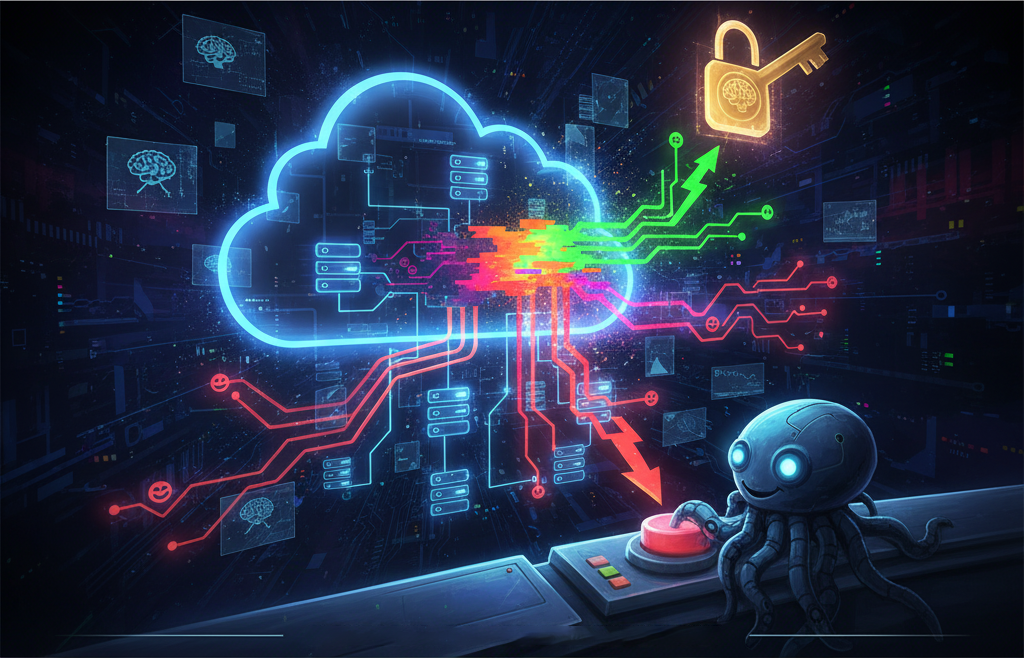Monoliths: The Tetris Approach
You might think engineers fear chaos, servers crashing, networks lagging, users complaining. But here’s the twist: cloud engineers actually love it.
Why? Because controlled chaos is a powerful way to make systems stronger, smarter, and more reliable. By intentionally testing failures in a safe environment, engineers uncover weaknesses before real users ever notice.
Chaos Engineering isn’t about breaking things for fun. It’s about building confidence, resilience, and trust in your systems. And once you see it in action, you’ll understand why engineers call it their secret weapon.
What Is Chaos Engineering?
At its core, Chaos Engineering is the practice of intentionally introducing failures into a system to see how it responds. The goal isn’t to break things for fun; it’s to reveal hidden weaknesses before they impact real users.
Think of it as a controlled stress test for your digital infrastructure, fully integrated with DevOps practices:
- Server failures: Shutting down individual servers to ensure the system reroutes traffic correctly, all while CI/CD pipelines monitor the recovery.
- Network disruptions: Introducing latency or dropping connections to test fault tolerance within automated deployment workflows.
- High-load scenarios: Simulating sudden spikes in traffic to verify auto-scaling rules and ensure smooth continuous delivery.
- Service dependencies: Disabling a critical microservice to check if other components recover gracefully and alerts are routed properly.
By systematically experimenting with failures through DevOps-integrated Chaos Engineering, organizations gain predictable insights into system behavior, improve incident response, and increase overall reliability.
Chaos Engineering transforms uncertainty into actionable intelligence, turning “what if it fails?” into a confident “we know how it will behave,” while keeping DevOps teams proactive rather than reactive.
Why Engineers Actually Enjoy Chaos Engineering
At first glance, intentionally breaking systems might seem stressful. But cloud engineers and DevOps teams actually love Chaos Engineering, and here’s why:
- Turns Stress Into Learning
Each controlled failure provides valuable insights. Engineers can pinpoint weak spots, refine infrastructure, and improve DevOps workflows before real incidents occur.
- Reduces Real-World Firefights
By testing failures in a controlled environment integrated with CI/CD pipelines and automated monitoring, teams face fewer production emergencies. Less panic, more confidence.
- Encourages Creative Problem-Solving
Chaos experiments challenge engineers to think like adversaries, anticipating issues that standard testing might miss, all while strengthening DevOps processes.
- Strengthens Collaboration Across Teams
Chaos Engineering brings DevOps, SRE, and product teams together. Everyone gains a shared understanding of system behavior, recovery protocols, and automated remediation.
- Builds Resilient, Self-Healing Systems
Over time, repeated chaos testing strengthens microservices, auto-scaling, and deployment pipelines, making systems more resilient and AI-ready.
In short, Chaos Engineering transforms uncertainty into predictable insights, empowering DevOps teams to plan, automate, and respond proactively, all while making systems stronger and more reliable
Real-World Examples of Chaos Engineering
Chaos Engineering isn’t just theoretical; it’s a proven practice used by leading tech companies to improve system reliability, strengthen DevOps workflows, and prepare for real-world failures.
Here’s how some of the biggest players use it:
Netflix – Chaos Monkey
Netflix pioneered Chaos Engineering with Chaos Monkey, a tool that randomly terminates servers in production. The goal is to ensure that systems auto-recover without affecting user experience. Integrated with DevOps pipelines, Chaos Monkey helps teams validate deployment resilience, failover strategies, and monitoring alerts, making their platform robust enough to handle millions of concurrent streams.
Amazon – Fault Injection for Resilience
Amazon conducts controlled outages in specific regions or services to stress-test their infrastructure. These experiments are tightly integrated with CI/CD and DevOps monitoring tools, helping engineers improve auto-scaling, dependency management, and incident response. This proactive approach reduces downtime, ensures seamless shopping experiences, and keeps the infrastructure ready for peak traffic.
Uber – Latency and Microservice Recovery Tests
Uber simulates network latency, disables critical microservices, or injects errors into ride-matching workflows. DevOps teams monitor automated recovery, orchestration, and alerting systems to identify hidden weaknesses. This enables Uber to maintain reliable operations for riders and drivers even during unexpected spikes or infrastructure issues.
Google Cloud – Chaos Testing in Kubernetes
Google Cloud uses chaos experiments on clusters to test pod restarts, container failures, and network partitions. Automated DevOps pipelines report, remediate, and document failures, allowing teams to continuously optimize deployments. This ensures high availability for customers relying on Google Cloud services worldwide.
Key takeaway: In each of these cases, Chaos Engineering combined with DevOps turns uncertainty into actionable intelligence. Engineers learn how systems fail safely, improve recovery workflows, and build confidence in releases, all without disrupting end users.
By seeing failure as a learning opportunity rather than a risk, businesses can adopt a proactive mindset, scaling confidently while minimizing downtime and customer impact.
How Your Business Can Benefit from Chaos Engineering
You don’t have to be Netflix or Amazon to take advantage of Chaos Engineering. Whether you’re managing a small cloud setup or a large-scale distributed system, introducing controlled chaos can completely change how you build, deploy, and maintain software. Here’s how you can benefit:
- Find Weaknesses Before Your Users Do
By running small, intentional failure experiments, you can identify hidden vulnerabilities in your systems. Instead of being blindsided by outages, you’ll know exactly where your infrastructure needs reinforcement.
- Improve Your Incident Response
Chaos Engineering is like a fire drill for your DevOps team. Practicing outages under controlled conditions means your team will be faster, calmer, and more effective during real incidents.
- Boost Your Customer Trust
Systems that survive failure gracefully, or recover instantly, inspire confidence. By proactively testing reliability, you’re ensuring your users enjoy a smooth experience, even when things go wrong behind the scenes.
- Scale With Confidence
Launching a new feature or expanding your infrastructure is less nerve-wracking when you’ve already stress-tested your system. Chaos Engineering combined with DevOps lets you scale boldly without fearing instability.
- Build a Culture of Resilience
You’re not just testing software; you’re training your team to expect the unexpected. Over time, this creates a culture of continuous improvement and adaptability, a competitive edge for any organization.
Bottom line: Chaos Engineering helps you go from reactive firefighting to proactive resilience. When combined with modern DevOps practices, it equips you to build systems that are not just functional, but predictably reliable under stress.
The AI-First Twist: How Wildnet Edge Does It
Chaos Engineering becomes even more powerful when combined with AI-first DevOps practices, and that’s exactly what we do at WildnetEdge. By integrating AI into your resilience strategy, you can predict, prevent, and respond to failures faster than ever.
Here’s how we apply it:
- Predictive Monitoring: AI continuously analyzes system behavior, spotting anomalies before they escalate into real incidents.
- Automated Recovery: When failures occur, AI-driven systems can reroute traffic, restart services, or trigger fallback processes without waiting for manual intervention.
- Optimized Microservices: AI helps balance loads across distributed services, ensuring each component runs efficiently under stress.
- Continuous Learning: Every chaos experiment feeds AI algorithms, improving future predictions, scaling decisions, and incident responses.
The result? Systems that are resilient, self-healing, and ready for unpredictable scenarios, giving you confidence to innovate without fear of downtime.
At Wildnet Edge, combining Chaos Engineering with AI-first DevOps transforms uncertainty into predictable reliability, letting you focus on growth, innovation, and delivering a seamless user experience.
Turning Chaos into Confidence
Chaos Engineering is a proven strategy to make your systems stronger, more reliable, and future-ready. By intentionally testing failures, integrating DevOps practices, and leveraging AI-first automation, you gain insights that prevent downtime, improve incident response, and keep users happy.
The big takeaway? Don’t fear failure, embrace it in a controlled way. Every experiment you run teaches your system how to recover, adapt, and thrive under pressure.
At WildnetEdge, we help you combine Chaos Engineering with AI-first DevOps to build self-healing, scalable, and resilient systems. Whether you’re scaling infrastructure, launching new features, or aiming for world-class reliability, we make sure your systems stay strong even when chaos hits.
Ready to turn uncertainty into confidence? Let’s build your AI-first resilient system together: Contact Wildnet Edge today!

Nitin Agarwal is a veteran in custom software development. He is fascinated by how software can turn ideas into real-world solutions. With extensive experience designing scalable and efficient systems, he focuses on creating software that delivers tangible results. Nitin enjoys exploring emerging technologies, taking on challenging projects, and mentoring teams to bring ideas to life. He believes that good software is not just about code; it’s about understanding problems and creating value for users. For him, great software combines thoughtful design, clever engineering, and a clear understanding of the problems it’s meant to solve.
 sales@wildnetedge.com
sales@wildnetedge.com +1 (212) 901 8616
+1 (212) 901 8616 +1 (437) 225-7733
+1 (437) 225-7733































